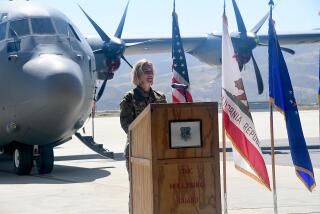Air National Guard Unit Logs Its 250,000th Hour of Accident-Free Flying : 146th Wing Flies By Key Milestone
- Share via
POINT MUGU — Shortly after one of its monster-sized, military-green cargo planes nosed up into the sky, the California Air National Guard’s 146th Airlift Wing flew past a key milestone Thursday.
Cruising up the sun-splashed coast toward San Luis Obispo, the crew logged the air wing’s 250,000th hour of accident-free flying, racked up over more than three decades.
The air wing planned the flight to mark what officials say is a major safety benchmark for the Air National Guard’s 92 flying units nationwide. Only one other wing--a unit based in Oklahoma City--has such bragging rights.
“This is a flight like any other, but this is also an important point to appreciate,” said Capt. Kimberly Holman, who co-piloted the plane on this landmark, 90-minute round-trip up the coastline. “It doesn’t come easy.”
The quarter-of-a-million hours of flying without a mishap amount to keeping a single plane in the air around the clock for 28 1/2 years, officials calculated Thursday.
Given that the 146th Wing’s planes have flown into wars, firestorms, floods and other major disasters, such a record was “a remarkable achievement,” said Maj. Gen. Bob Barrow, commander of the California Air National Guard.
The 146th Wing recorded its last accident in October 1965, when a C-97 Stratofreighter had a “hard landing” at a Palmdale airstrip. The plane touched down with its landing gear up, resulting in no injuries but causing damage to the aircraft.
“If we hadn’t had that, our record would probably go back much further,” air wing Lt. Col. Ed Bellion said.
The day began inside the C-130’s boxcar-sized cargo hold amid the howling of propellers and the faint smell of fuel. After safety checks and a flight briefing by a staff sergeant, the 82,000-pound turboprop rumbled down the airstrip at Point Mugu and was airborne shortly after noon.
“Gears are up,” Holman announced as the plane began a steep ascent. “Clear to the right.”
As the ground dropped away and the aircraft veered north over the Pacific, the oil rigs below shrank into small squares studding the white-capped ocean.
About an hour into the flight, the crew opened the C-130’s jaw-like rear cargo door, revealing postcard views of pea-green hills and jagged cliffs.
*
Maj. Marlene Mahoney, an air wing flight nurse who helped evacuate injured soldiers on C-130s during Operation Desert Storm, gaped as she spotted the Piedras Blancas lighthouse near San Luis Obispo.
“I keep saying I’ll get tired of this, but it never gets old,” said Mahoney, a reservist from Newbury Park who works for an insurance company. “I can’t believe I didn’t bring my camera.”
The flight went off without a hitch, and the plane taxied to a mammoth hangar where dignitaries and a cake spelling out the number 250,000 awaited.
But Thursday’s event came soon after a U. S. Navy F-14 Tomcat crashed overseas, marking the third accident involving that particular jet in less than a month. Lt. Col. Michael Ritz said the recent crashes troubled him and have further spotlighted the importance of safety.
“The way to alleviate that is through training and through the maintenance of equipment you are flying and dedication of the personnel,” said Ritz, the air wing’s chief executive officer. “And, of course, there is luck.”
*
Luck has been on the air wing’s side in its mission to defend the country while serving alongside the Air Force. With duties ranging from hauling troops and military supplies to evacuating injured soldiers, the 146th Wing was deployed in the Persian Gulf and other areas during Operation Desert Storm.
The guard unit also flew 1,647 passengers and more than 363 tons of cargo during the 1990 military operation to topple Panamanian leader Manuel Noriega.
In peacetime, the air wing uses its forces--more 1,200 reservists and full-time personnel--to fly humanitarian relief efforts during such disasters as earthquakes, fires, hurricanes and floods.
Earlier this month, the air wing dispatched a plane filled with 250,000 empty sandbags to Portland, Ore., a scene of heavy flooding.
The 146th Wing is also one of only four Air National Guard units that back up civilian tanker planes by flying firefighting missions.
“It is the most difficult and dangerous peacetime flying there is,” said Tech. Sgt. Michael Drake, a base spokesman. “You are flying over a fire and are unloading 27,000 pounds of [orange fire retardant] in just six seconds. We have had planes that come back with the tops of trees in them.”
*
Crews from the base estimate that they flew nearly 600 missions over California, Arizona and Idaho during 1994 fires, dropping about 1.6 million gallons of fire retardant.
Based at Van Nuys Airport for 40 years, the air wing moved in 1990 to a new, $64-million base a few miles south of Oxnard near the Point Mugu Naval Air Weapons Station.
Mahoney, the flight nurse, stuck with the air wing through the move and said she can’t imagine leaving a part-time job that means she could be called to serve at any moment.
“I was looking for something different,” said Mahoney, 40. “I’ve been doing this for 14 years. It’s now just part of my life.”
More to Read
Sign up for Essential California
The most important California stories and recommendations in your inbox every morning.
You may occasionally receive promotional content from the Los Angeles Times.













